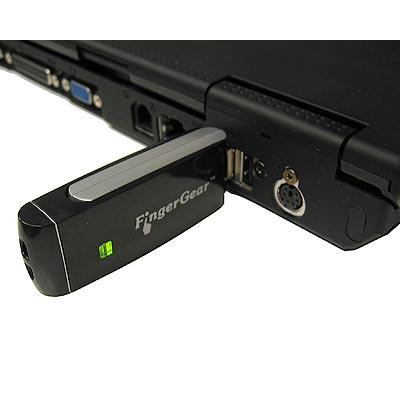
To begin, we need to indulge in a little truth-in-advertising exercise. FingerGear's Computer-On-a-Stick is not, in fact, a computer of any kind. There's nary a processor to be found on the little beastie. What it is, in fact, is a nicely packaged bootable Linux image squeezed onto a USB memory stick along with some NVRAM to let you store content. When you plug it in to a late-model PC that supports booting from USB storage devices and tell the BIOS to boot from it, it fires up a 2.6-based Debian Linux distribution, preconfigured with Firefox, OpenOffice.org, Evolution and Gaim. The processor, system memory, graphics card, networking and display of the host system are used.
The first time you boot off the stick, it sets up a password so that if stolen, people can't get their hands on your data. Beyond that, it's a single-user device, so no multiple desktop environments are going to be happening. The innovating thing (and what sets the FingerGear product apart from a bootable CD) is that your home filesystem and all other system configurations move around with you, stored on up to 1GB of nonvolatile RAM. The 256MB sticks start at $99 US, with the 1GB versions at $179 US. The intended use is for road warriors who may find themselves at a client with time to kill and a PC in front of them. By plugging in the stick, they are instantly set up to read their mail, continue editing documents they have been working on and chat with their friends via IM, without the hassle of configuring the local mail client on the client's PC and so forth.

I tested the unit on a Toshiba laptop and the Linux Journal test PC (an AMD 3200+). In the case of the laptop, there is no option to boot from USB devices, so I used the enclosed mini-CD to do the initial boot, after which the FingerGear stick took over. Unfortunately, in spite of the recent 2.6 kernel, it totally failed to recognize my Wi-Fi chipset. Of course, if you've already got a laptop, why are you using the FingerGear product?
Testing on the Linux Journal test system was more fruitful. Although the BIOS supports booting from a USB device, I got the ever-helpful “Boot failed” message when I tried. Again, booting from the mini-CD solved the problem. Once up, DHCP automatically configured the networking and I was off. Firefox worked fine, and I was even able to do things like install the Macromedia Flash plugin. The Office suite performed as expected. Boot time was nearly instantaneous.
The Computer-On-a-Stick is a clever idea, but one has to question the practicality of the intended use. I kept finding myself envisioning attending a typical tradeshow and proposing to the staff running the public press PCs that I be permitted to reboot one of their PCs. The same thought applies to most corporate network admins. You could, of course, apply the “It is better to ask forgiveness than permission” maxim, but it wouldn't be advisable most places I've worked. The “plug it in and it works” networking would probably also have difficulties in any setting with extensive firewalling and proxy configuration required. So I'm not sure how many settings would actually work out practically with the FingerGear concept.
There's also the issue of security. Properly packed with a hacker toolkit, one of these sticks could be the ultimate penetration tool. Boot it up, and own the attached network. Thankfully for the sleep of administrators around the world, the current release of the product doesn't provide any way to access the local disk. However, FingerGear has indicated that a future product will allow just that functionality, which, under friendly conditions, would let an administrator boot up a toasted disk drive and fix things. Under less-sincere circumstances, it would be just the toy to go data-raiding in any physically accessible computer you happened across.
In summary, the Computer-On-a-Stick is a nice idea that may be the right solution for you. Whether it is or not will depend largely on what type of computers you plan to use it with. If you frequently find yourself in locations with generic computers that you will have permission to reboot, it will definitely let you surf, read mail, edit documents and IM without leaving a trace on your hosts' computers. But if the thought of rebooting other people's systems makes you nervous, you might just want to settle for a plain memory stick and other solutions, such as Web mail.